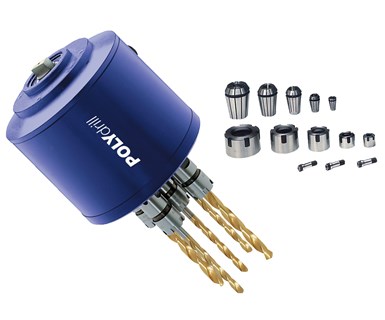Suhner's PolyDrill Multi-Spindle Drilling Heads Available in Various Configurations
The PolyDrill series of multi-spindle heads, available from Suhner, includes fixed and adjustable hole pitches and compact models.
Share






The PolyDrill series of multi-spindle heads, available from Suhner, includes fixed and adjustable hole pitches and compact models. Drilling capacity ranges from 0.06" to 1" (1.5 and 25 mm). Minimum hole spacing is 0.27" (7 mm), while maximum hole spacing is virtually limitless. Optional tool holders include ER, ST, JT33, Weldon and other customized styles. Options include axial and radial compensation as well as custom layout and spacing.
The MH 20/5, MH 20/7 and MH 20/10 multi-spindle heads have maximum speeds of 4,000 rpm. Maximum drilling capacities are 5, 7 and 10 mm, respectively. The MH 20/13 head has a maximum drilling capacity of 13 mm and a maximum permissible speed of 3,000 rpm.
The MHF can be equipped with up to 10 spindles in a custom pattern and fixed spindle distance. Maximum drilling capacity ranges from 5 to 13 mm with speeds ranging between 2,500 and 4,000 rpm. The MHFP is equipped with eight spindles with preloaded angular contact bearings for use with carbide tools and fixed spindle distance. Maximum drilling capacity is between 7 and 20 mm with a speed range of 0 to 8,000 rpm.
The VG 4-8 drive system can power up to eight machining units with a single motor with flex shaft power delivery. The speed range for this drive system is between 46 and 9,320 rpm. Flexible drive shafts NA 7, 10 and 12 provide speeds ranging from 12,000 to 20,000 rpm.
Related Content
-
Tungaloy Drills, Milling Inserts Provide Enhanced Stability
Tungaloy has expanded its DrillForceMeister and TecMill lines with new drill bodies and milling inserts.
-
OSG End Mills Provide High-Efficiency Milling
The company has expanded its range of end mills with two offerings for high-speed milling.
-
How to Mitigate Chatter to Boost Machining Rates
There are usually better solutions to chatter than just reducing the feed rate. Through vibration analysis, the chatter problem can be solved, enabling much higher metal removal rates, better quality and longer tool life.












